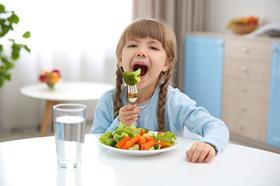
On the day it released the latest version of its Consumption Monitor, Freshfel Europe said the sector should 'act now' to make up the consumption gap to the World Health Organization's minimum recommendation of 400g of fresh produce each day.
Consumption Monitor figures indicated that fruit and vegetable consumption decreased to 349.19g/capita/day in 2019, and Freshfel urged the fresh fruit and vegetable business to build on the environmental, climate, and health benefits of a plant-based diet throughout 2022, with the goal of 400g/capita/day.
The Consumption Monitor is based on figures up to 2019, complemented by an analysis of the consumption trends in 2020 and 2021, years heavily influenced by the COVID-19 pandemic.
Plenty of optimism
“The fresh produce sector has many reasons to be optimistic considering the assets of fresh fruit and vegetables,' said Stephan Weist, president of Freshfel Europe.
'We also need to be ambitious,' he continued. 'Every additional 10g consumed by a European per day, would lead at the end of the year a market size boosted by 1.8m tonnes. Adding one piece of fruit or vegetables and raising the average consumption over the 400g recommended by the WHO would mean the need to supply almost 15m tonnes more per year.”
During a Freshfel workshop, experts from across Europe and the supply chain agreed to “Act Now”, which was also one of the mottos of the International Year of Fruits and Vegetables 2021.
It was agreed that the fruit and vegetable sector should capitalise on the momentum built by the consensus between political leaders, consumers, and NGOs regarding the benefits of increasing the consumption of fruit and vegetables for the planet, the climate, and the health of the consumers themselves.
Consumer trends
Experts also reviewed the latest trends in 12 EU member states as well as in the UK and, while each market has its own specifics, it was apparent that there are many commonalities regarding the expectations of European consumers.
The most efficient strategy to boost consumption, it was suggested, would focus on consumers with less prevalence towards healthier food rather than preaching to the converted.
The youngest generation, particularly millennials, should be prioritised, and setting consumption targets such as the 5-a-day campaign, eating in colour, and having half a plate of fruit and vegetables were important concepts to help consumers hit 400g per day.
“The findings from local studies agree that consumers across Europe care for taste, freshness, vitamins and minerals, added value, convenience and seasonality,' said Philippe Binard, general delegate of Freshfel Europe. 'Aspiration towards sustainability is only indirectly transpiring from their food choice while looking for local or organic products.”
Despite concerns over the unstable economic situation, the shift of purchasing power between the east and west EU based on the evolution of disposable net, and increasing inflation, the sector would have to position itself correctly to convince new consumers to buy more fruit and vegetables – in particular those prepared to pay more for higher quality.
“Moving towards higher prices and better retribution for high quality and value for fruit and vegetables could help the sector, which operates with tight margins to address the latest price increase across the supply chain,' Binard continued.
'In recent months, costs are rising sharply in particular for production input, road and sea logistics, packaging, energy, wages while consumers prices are almost stable,' he outlined. 'One option to explore to alleviate the pressure would be to move across Europe to VAT exemption, considering fruit and vegetables as public goods, given their assets to address the current environmental, climate and health societal challenges.”
Retail detail
Freshfel Europe members and EuroCommerce used the Workshop to review the initiatives undertaken by retailers in their pledge to act sustainably and develop multiple in-store initiatives to move consumers towards a plant-based, healthier diet.
The most noticeable initiatives included rethinking supermarket choices and offers, improving access to fresh produce and their quality, developing loyalty programmes for healthier food choices and encouraging fruit and vegetable consumption with campaigns, such as 'Peas Please' and other initiatives to enhance the consumption of 'super foods'.
Online sales have grown significantly during the pandemic, so Freshfel Europe members also reviewed the latest trends for online shopping.
“This segment remains very fragmented and with very different penetration rates across the EU,' explained Nelli Hajdu, director for business development at Freshfel Europe. 'Different models are being developed across Europe, from Click and Collect to home delivery, as well as other concepts including online purchases from growers or home delivery of entire meal packs.
'The development of online sales for convenience and lifestyle, however, further demonstrates that consumers are ready to pay more for services like home delivery as several studies confirmed that the online segment is growing even if they report the highest price per kg,' Hajdu said.
Busy time ahead
Given the analysis conducted, Freshfel said that the sector had 'a busy agenda ahead' for 2022.
”Freshfel Europe will work actively in 2022 towards new opportunities for the sector, resulting not only following a Farm to Fork strategy but also and importantly from a Fork to Farm perspective,' said Binard.
'The workshop demonstrates the importance to meet the diversity of consumers' expectations and supply products according to their preferences always for high quality, great taste and texture as well as freshness and convenience.
'Boosting consumption will ultimately be a win-win-win situation, for the planet, the health of consumers, and the sector, with the objective of boosting consumption well over the 400g, leading to a market size growth by almost 20 per cent, which represents close 15m tonnes.'





